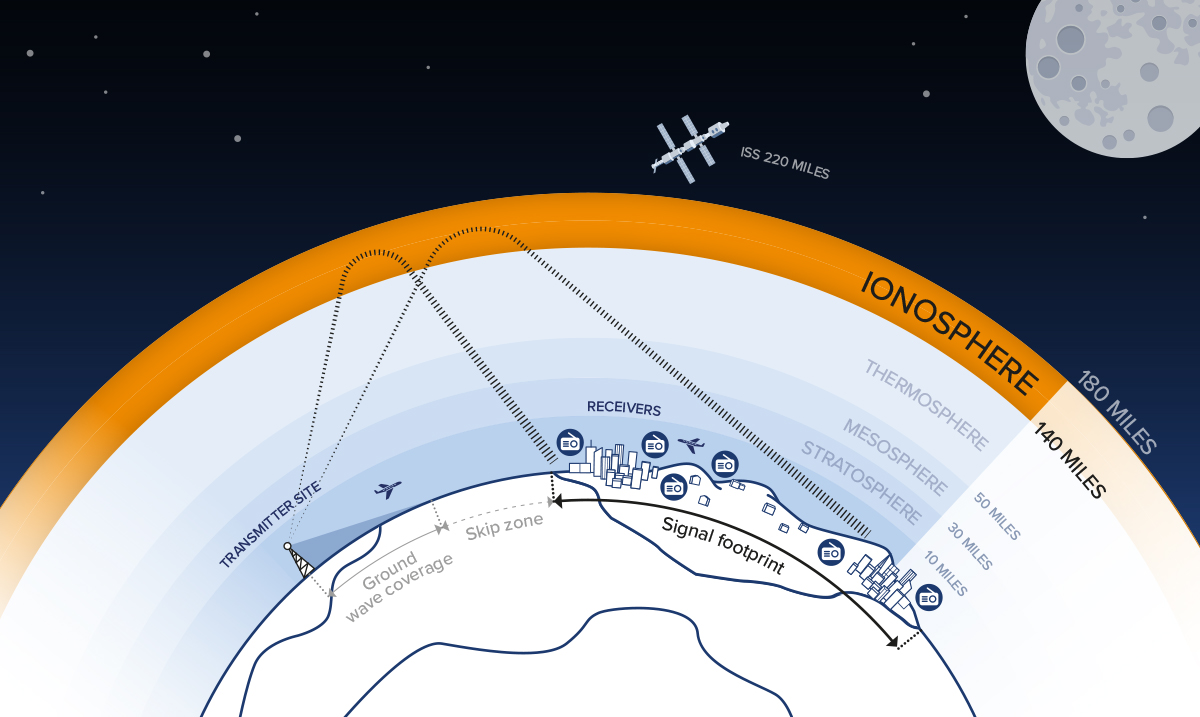By Neale Bateman, BBC Account Manager, Encompass Digital Media
Despite a slow decline over the past two decades, the use of high-frequency (shortwave) bands for national and international radio broadcasting remains a uniquely effective and efficient medium for reaching millions of listeners with a single transmitter. Bringing reliable and impartial news and information to global audiences provides a lifeline for remote populations who depend on a trustworthy source of information and education. And, never has this been demonstrated more starkly than during the first few months of 2020.
The physics of why shortwave transmissions behave in the way they do is complex. However, by using a well-planned service and the right frequency at the right time of day, broadcasters can serve the population of an entire continent beamed from a transmitter thousands of miles away.
Unlike other broadcast bands (notably FM and medium wave), shortwave signals can be steered towards the sky. Rather than radiating horizontally along the ground, shortwave is reflected back to earth, illuminating large geographical areas several thousands of miles away. The same principle applies regardless of whether traditional analogue or digital (DRM) mode is used, making DRM digital radio on the SW bands a compelling proposition to deliver high-quality audio to mass audiences over very wide areas.
The mechanism for this magic is the ionosphere, which extends from about 80 to 1,000 km above the earth’s surface and contains a high concentration of ions and free electrons that reflect radio waves. Several layers of these charged particles are sensitive to sunlight, and the effect varies with the density and composition of the ionosphere depending on a number of factors. Local daylight hours and the time of year are two of the main influences, as the earth’s oblique orbit around the sun moves our planet between the seasons.

The very useful property of shortwave signals travelling long distances does present a drawback. The same frequency cannot be used all day long or all year round for that matter. This is because the diurnal and seasonal changes in the number of daylight hours at any location have a direct effect on the optimum frequency band at any given time. The sun itself also undergoes a much longer period of change, known as the sunspot cycle. Based on observations over many centuries, this variation in solar activity peaks around every 11 years. Long-term predictions concerning which frequencies can be used and when can, therefore, be made with a reasonable degree of accuracy. This is an important factor in the art of frequency planning.
As a general rule, higher frequencies work best during daylight hours and summertime (in the northern hemisphere), while lower frequencies propagate better in darkness (before dawn and during the long winter evenings), especially when the sunspot cycle is at its lowest ebb. The problem, of course, is that the same rules apply to everyone. So in periods of low solar activity, the lower frequency bands are crowded with every broadcaster trying to use the best possible frequency for their service.
Management of the shortwave broadcast bands is an international affair. Every country has its own national organisation or governing body for legislating internal broadcasting (such as Ofcom in the UK). At an international level, the ITU (International Telecommunications Union), an agency of the United Nations, performs the role of worldwide administration of radio regulations and spectrum planning. Every member state of the UN subscribes to the ITU, even if not all abide by its rules.
Within the auspices of the ITU, the High Frequency Co-ordination Committee (HFCC) manages and co-ordinates global databases of international shortwave broadcasting. Encompass’ expert team of frequency managers represent the BBC and other customers’ interests at this forum. The HFCC meets several times a year to co-ordinate the frequencies used by all of the world’s major broadcasters.
The output from the HFCC is two seasonal frequency schedules – summer and winter – known as the ‘A’ and ‘B’ seasons. The changeover between seasons is internationally agreed upon to occur on the last Sunday in March (start of ‘A’ season) and the last Sunday in October (start of ‘B’ season). The seasonal rollover coincides with the start and end of Daylight Saving Time in many countries that change their local clocks.
Thus, the start of the new ‘A20’ season is Sunday 29th March, and the frequencies agreed for all shortwave transmissions will continue until the beginning of the ‘B20’ season on Sunday 25th October.
Encompass Digital Media is a recognized expert in radio distribution with a global network of owned and operated transmitters. Contact us to explore and discuss the best way to broadcast your message where it matters.

